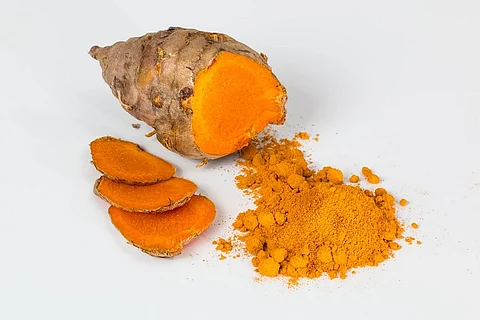

In a significant development that could be a breakthrough in the treatment of cancer, Sree Chitra Tirunal Institute for Medical Sciences and Technology (SCTIMST) in Kerala’s Thiruvananthapuram has been granted a US patent for a technology developed using a compound extracted from turmeric.
Curcumin, which is a bright yellow chemical compound extracted from turmeric, could potentially be used for sustained delivery of a potential chemotherapeutic molecule in and around cancer tissues, the research shows.
The patent has been granted to the tech which is jointly owned by SCTIMST - a renowned institute in the field of developing technologies in healthcare - and the Indian Council for Medical Research (ICMR), which funded the research.
This is not the first time that scientists have discussed the anti-cancer properties of curcumin, which has long been known to be effective in curbing tumour growth. However, the structure of curcumin is water-insoluble which made it difficult for testing and administering the compound. SCTIMST’s technology has found a way to overcome this problem.
Dr Lissy Krishnan of the Biomedical Technology wing of SCTIMST developed the technology making curcumin water-soluble by conjugating it with a protein called albumin.
This curcumin, which was bound to albumin, was tested on animals last year. It was found that the tumours in the animals shrunk after the administration of curcumin. Dr Lissy was able to show that a cancer tissue can regress if curcumin is given intravenously. However, this technology still requires large scale animal as well as human trials before it can be introduced as a treatment.
“It’s a well-known fact that curcumin, which is an extract from turmeric, has anti-cancer properties. But this has only been established in tests on cancer cells in laboratories. It has not been possible to test it on human patients of cancer, because the water insolubility meant it could not reach the cancer cells,” Dr Asha Kishore, Director of SCTIMST, explains.
“Normally we introduce any drug into the system either by taking it as a tablet or by injection -- either through the veins or directly injecting into the muscles. However, curcumin was not originally water-soluble. And if taken through diet, it doesn't enter the bloodstream in sufficient quantities, and will not get absorbed in the intestines in the required amount. As a result, the compound is rendered ineffective against the cancer cells,” she adds.
The ‘wafer’ and local application
The technology developed makes it possible for curcumin to be applied directly on the tumour.
Presently, if a doctor can’t cut and remove a tumour beyond a point during surgery because it has adhered itself to other tissues, normally, powerful chemotherapy drugs are administered intravenously. This may be accompanied by radiation too. Both damage healthy tissues as well. With the SCTIMST technology, the aim is to administer the curcumin locally to the affected tissue during surgery, which should destroy the remaining tumour cells.
"However, curcumin can’t simply be sprinkled like a powder on the affected tissue. Dr Lissy has developed technology of making a ‘wafer’ or a thin paper-like material which contains curcumin and two normal human proteins -- albumin and fibrinogen. They all are conjugated and subjected to a process called freeze-drying which combines all three in a dry substance. If the paper containing these three is placed directly on the cancer tissue, curcumin along with albumin can directly get into the cancer cells from the wafer. We believe it will subsequently kill the cancer cells,” Dr Asha says.
As for the remaining wafer, the fibrinogen protein comes into play. Fibrinogen, which is necessary for the blood to clot, gets converted into fibrin or a blood clot and doesn’t do any harm locally. The blood clot will be removed from the body by a local mechanism.
“It’s now for the drug developing company to conduct trials using such wafers in animals,” Dr Lissy says. “If found effective, it should be tested on humans too. We anticipate that curcumin applied through a wafer is an effective treatment for cancer. Since it can be applied locally on the affected tissues, the effects and side-effects that would be local only. We are not anticipating any major side-effects,” she added.
The technology took over four years to develop, and it is expected that it will take another four to conduct the necessary trials.